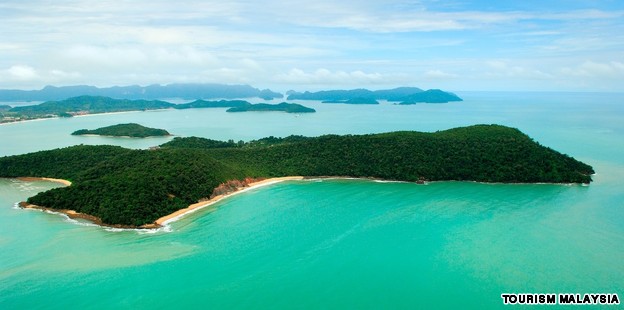
Travelers passing through Southeast Asia often describe Malaysia as the perfect balance between tourist-heavy Thailand to the north and clean, orderly Singapore to the south.
It serves up enough grit and color to ward off the sort of sterility most seasoned travelers loathe, yet offers luxury comforts, as well.
Cameron Highlands: Malaysia’s enduring ‘Little England’
Taking in the best of this 330,000-square-kilometer country in your average two-week visit is impossible.
There’s Mount Kinabalu to climb, the Cameron Highlands to sip tea in, the waters of Sipadan to dive and the ancient Taman Negara rainforest to stomp through, to name a few.
But first-timers who are short on time can experience the best of Malaysia’s beaches, food, culture, wildlife and shopping by hitting up its three most popular destinations — Penang, Langkawi, Kuala Lumpur — which are all connected by daily flights operated by a number of airlines.
George Town, Penang
Pace yourself or you’ll get fat.”
Blunt words of wisdom from a local watching me plow through my plate of lamb rending and squid eggs during my first meal in Penang’s capital, George Town.
He’s right.
UNESCO-listed George Town isn’t a destination to hit if you’re big on dietary austerity — eating will consume much of your thought process while you’re there.
Gallery: Malaysia’s best dish is …
“What should I have for lunch today? Nasi Lemak? Maybe a bowl of laksa? Char kuey teow?”
A food tour is among the easier ways to get acquainted with the local eats.
For something personalized, Penang-based food and travel journalist Robin Eckhardt offers private tours, which need to be booked at least five weeks in advance.
Eckhardt’s “EatingAsia Street Food Excursion” is a reflection of her belief that the best way to get to know a destination is through its cuisine.
Her most popular excursion is on foot and hits up George Town’s culinary highlights, taking two to three hours.
To learn how to cook some of Penang’s most popular dishes when you get back home, Nazlina Spice Station offers regular classes in a small shop house in central George Town.
Sessions include a visit to nearby markets and last three to five hours.
Owner Nazlina also does private dinners for two people or more, by reservation only. Her website has more info on days/times/menus.
Try as you may, you can’t spend your entire time in George Town eating. Here are some other Penang attractions worth checking out.
Gallery: Asia’s first Legoland opens in Malaysia
ld George Town is a walker’s dream. Earning its World Heritage designation back in 2008, there are dozens of historic landmarks, from old English colonial mansions to Malay, Thai and Indonesian architecture.
Among these are the stunning Kapitan Keling mosque, Little India, Armenian Street and Fort Cornwallis.
Guided heritage walks leave from George Town’s PHT Office every morning at 9 a.m. (26 Church St., opposite Pinang Peranakan Mansion).
Visit the Penang Tourism website for more info.
Penang Hill
On a clear day, the views of George Town and beyond from atop Penang Hill are unrivaled, while the difference in climate atop the 2,750-foot mound will make you forget you’re in the tropics.
The speedy ride up the hill on the funicular is an unexpected thrill.
What I didn’t realize, though, is that the lines to get the funicular back down can be fairly long if you go in the late afternoon. But not long enough that for one moment I even considered walking back down via the trail, a jaunt that staff say can take as long as three hours.
Though Malaysia on the whole is predominantly Muslim, in Penang the majority of the population is Chinese. Hence the significance of the massive Kek Lok Si — or Temple of Supreme Bliss.
Highlights include the Pagoda of 10,000 Buddhas and a 30-meter-high bronze statue of goddess Kuan Yin.
If that doesn’t sate your theological interest, Wat Chayamangkalaram and the Dhammikarama Burmese Buddhist Temple peer across from one another on George Town’s Burma Road.
Wat Chayamangkararam is a Thai temple featuring a 180-foot, gold-plated statue of the reclining Buddha.
Dhammikarama is filled with quirky shrines alongside the classic pagodas and statues one normally associates with Burmese Buddhist art.
The Baba Nyonya people, also known as Peranakan or Straits Chinese, are mainly of Chinese descent, originally from Fujian Province in southeastern China.
Penang has a long and proud Baba Nyonya heritage, which has adopted many aspects of local culture.
The place to learn more Baba Nyonya life is the Peranakan Museum on Church Street. It’s set in a restored mansion built near the end of the 19th century.
The former home of Kapitan Chung Keng Kwee, a leader in the Penang Chinese community, it features thousands of antiques and displays highlighting the culture of the time.
There’s also the Blue Mansion, former home of Chinese merchant Cheong Fatt Tze, and built in the 1880s. The bright, indigo-blue property has been restored and is now a boutique hotel.
Daily tours start at 11 a.m., 1:30 p.m. and 3 p.m.; no need to book ahead.
A boutique hotel boom has taken place in George Town since it’s UNESCO heritage designation, with local entrepreneurs going on a renovation binge.
One of the more popular Penang hotels is 23 Love Lane Penang, a luxury property in a renovated heritage building with modern musts like iPod docking stations and free WiFi.
If boutique hotels aren’t your thing and you’d prefer to have a nice, big pool to retreat to after an afternoon of gorging on some of Malaysia’s best eats — heritage hotel Eastern and Oriental is as good as it gets.
The very first enterprise of the famed Sarkies Brothers — the Armenian siblings behind the Raffles Hotel in Singapore — the stark, white structure was one of the earliest major historic buildings in George Town.
Today, it’s still about tropical gardens, manicured lawns and G&T sundowners on the veranda.
There are two connected buildings, the heritage wing and the new Victory Annexe, which opened in March this year.
If you want space, the 135-square-meter Writer’s Suite, with a large private balcony, is a stunner.
Eastern & Oriental, 10 Lebuh Farquhar, Penang; +60 (0)4 261 8333; rooms from $240 per night












